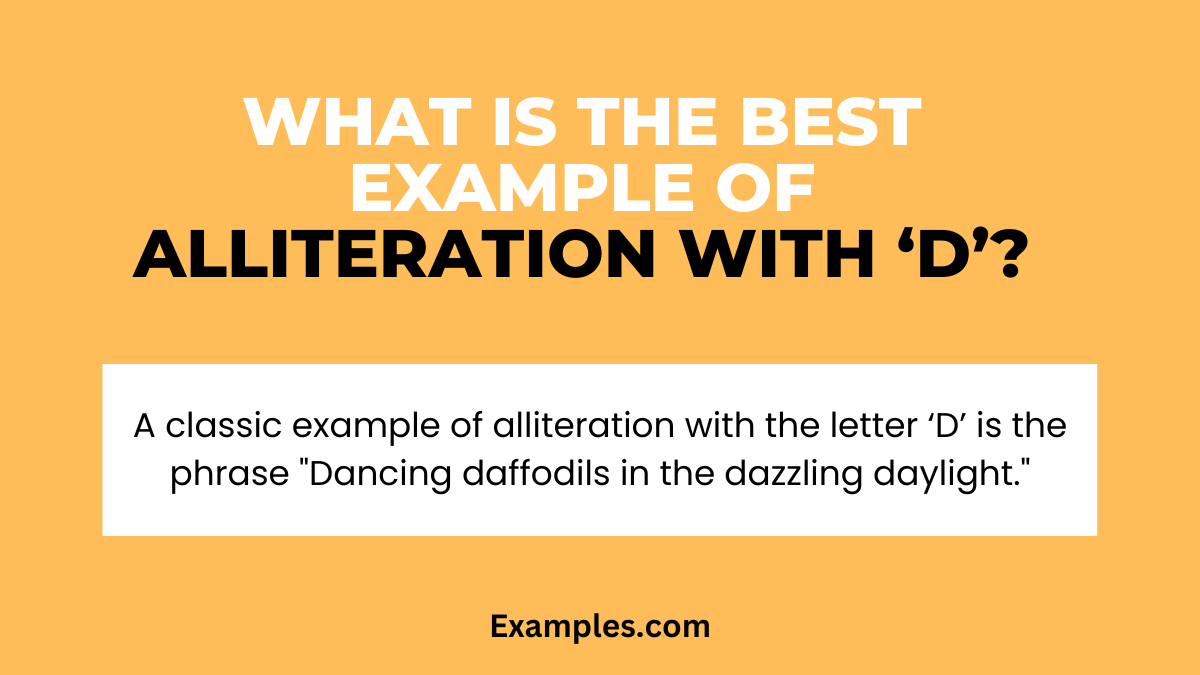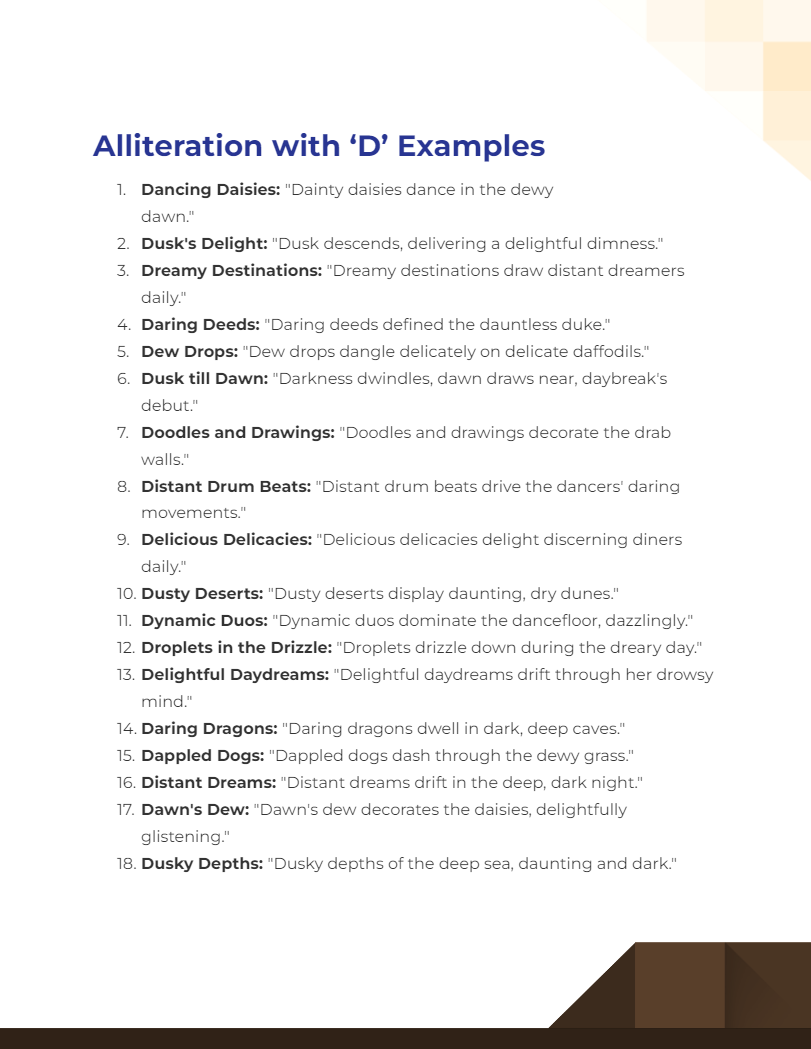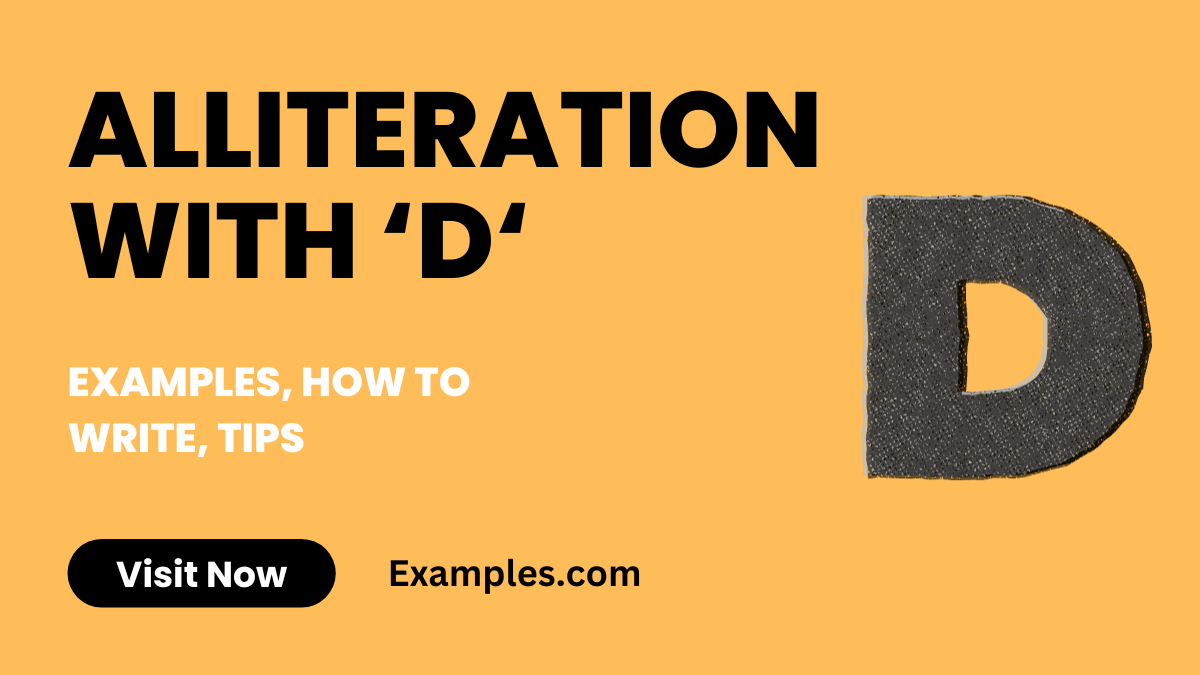17+ Alliteration with D Examples
Alliteration with the letter ‘D’ is a delightful and dynamic literary device that can add depth and dimension to writing. It involves the repetition of the ‘D’ sound at the beginning of closely connected words, creating a rhythm and enhancing the text’s musicality. When crafting alliterative and assonance sentences with ‘D,’ focus on word choice to ensure that the repeated sound doesn’t overpower the message. This technique is particularly popular in poetry and prose, where it can evoke emotions, emphasize particular points, or simply make the language more engaging and memorable. As with any stylistic device, moderation is key to prevent overuse, which might distract from the content’s essence.
Download Alliteration with 'D' Examples
Download Alliteration with 'A' to 'Z' Examples
What is the Best Example of Alliteration with ‘D’?

Example: A classic example of alliteration with the letter ‘D’ is the phrase “Dancing daffodils in the dazzling daylight.”
Meaning: This Easy Alliteration is a literary device that involves the repetition of the same consonant sound at the beginning of consecutive words in a sentence or phrase. In the example, “Dancing daffodils in the dazzling daylight,” the consonant ‘D’ is repeated, creating a rhythmic and melodious quality to the phrase. This technique is often used in poetry and literature to enhance the sound and flow of the language, making it more engaging and memorable for the reader or listener.
20 Alliteration with ‘D’ Examples

Download Alliteration with 'D' Examples in PDF
Alliteration with the letter ‘D’ brings a dynamic, dramatic, and sometimes delicate touch to language. The ‘D’ sound, with its definitive and clear articulation, provides a strong rhythmic foundation for phrases and sentences. Utilizing ‘D’ in alliteration can convey a range of tones, from soft and dreamy to bold and direct. Below are 20 unique examples of alliteration in rhymes with ‘D’, each coupled with a fitting rhyme title to encapsulate the essence and mood of the alliteration.
- Dancing Daisies “Dainty daisies dance in the dewy dawn.”
- Dusk’s Delight “Dusk descends, delivering a delightful dimness.”
- Dreamy Destinations “Dreamy destinations draw distant dreamers daily.”
- Daring Deeds “Daring deeds defined the dauntless duke.”
- Dew Drops “Dew drops dangle delicately on delicate daffodils.”
- Dusk till Dawn “Darkness dwindles, dawn draws near, daybreak’s debut.”
- Doodles and Drawings “Doodles and drawings decorate the drab walls.”
- Distant Drumbeats “Distant drumbeats drive the dancers’ daring movements.”
- Delicious Delicacies “Delicious delicacies delight discerning diners daily.”
- Dusty Deserts “Dusty deserts display daunting, dry dunes.”
- Dynamic Duos “Dynamic duos dominate the dancefloor, dazzlingly.”
- Droplets in the Drizzle “Droplets drizzle down during the dreary day.”
- Delightful Daydreams “Delightful daydreams drift through her drowsy mind.”
- Daring Dragons “Daring dragons dwell in dark, deep caves.”
- Dappled Dogs “Dappled dogs dash through the dewy grass.”
- Distant Dreams “Distant dreams drift in the deep, dark night.”
- Dawn’s Dew “Dawn’s dew decorates the daisies, delightfully glistening.”
- Dusky Depths “Dusky depths of the deep sea, daunting and dark.”
- Dazzling Displays “Dazzling displays of dazzling fireworks light the dark sky.”
- Delicate Dances “Delicate dances in the dim moonlight, dreamily swirling.”
Alliteration Sentence Examples with ‘D’
Alliteration sentences with ‘D’ deliver a distinct and dynamic rhythm, often creating a deep, dramatic effect. The ‘D’ sound, with its definitive tone, adds emphasis and engagement to the text. Here are three examples:
- “Daring divers dove deep into the dark depths.”
- “Dusk’s dimness draped the deserted docks delicately.”
- “Diligent dogs diligently dug in the dusty dirt.”
Alliteration Examples with ‘D’ Words
Using ‘D’ words in alliteration offers a delightful and sometimes dramatic effect in phrases for hard alliteration, enhancing their musicality and memorability. Here are three examples:
- “Dusty documents, dated and dog-eared, lay dormant.”
- “Daisy’s delightful desserts drew daily diners downtown.”
- “Dark dragons dreamt of dewy dawns in distant lands.”
Alliteration Examples with ‘D’ Name
Incorporating names that start with ‘D’ in alliteration adds a personal touch, making phrases more relatable and vivid. Here are three examples:
- “David’s daring dog darted through the dense woods.”
- “Diana danced daintily during the delightful dinner.”
- “Derek’s drawings depicted distant, dreamy destinations.”
Alliteration Beginning with ‘D’
Alliteration beginning with ‘D’ sets a decisive tone, often used to create emphasis or to draw the reader’s attention. Here are three examples:
- “Droves of daffodils decorated the dale at dawn.”
- “Dimly lit, the dungeon’s dampness was discernible.”
- “Dawn’s daylight dispelled the darkness decisively.”
How to Write Alliteration with ‘D’?
Writing alliteration answers with the letter ‘D’ involves the repetition of the ‘D’ sound at the beginning of closely connected words. This technique adds a rhythmic and emphatic quality to writing. Here’s a step-by-step guide to mastering alliteration with ‘D’:
- Understand the ‘D’ Sound: Familiarize yourself with the sound of the letter ‘D’. It is a plosive consonant, which means it has a strong, abrupt sound, creating emphasis in speech and writing.
- Choose a Theme: Determine the theme or subject of your writing. This helps in selecting appropriate words that start with the letter ‘D’ and are relevant to your context.
- Brainstorm ‘D’ Words: Compile a list of words starting with ‘D’ that relate to your theme. Consider a mix of adjectives, nouns, and verbs for variety.
- Formulate Your Phrase or Sentence: Construct a sentence or phrase using your chosen ‘D’ words. Arrange them to create a pleasing rhythm and ensure they make sense in the context of your theme.
- Read Aloud for Rhythm: Alliteration is as much about sound as it is about meaning. Read your sentence aloud to check the rhythm and flow.
- Revise for Impact: Edit your sentence to maximize its impact. Ensure that the alliteration enhances the message without overwhelming it.
- Incorporate into Your Writing: Once satisfied, weave your alliterative phrase into your larger piece of writing, whether it’s a poem, story, or an essay.
Tips for Using Alliteration with ‘D’
Here are the Tips for Using Alliteration with ‘D’:
- Use Sparingly: Alliteration is a powerful tool but can be overwhelming if overused. Use it to highlight key points or to add a poetic touch, but don’t let it dominate your writing.
- Ensure Clarity: Your sentence should remain clear and understandable. Don’t sacrifice clarity for the sake of alliteration.
- Vary Word Lengths and Types: Mixing short and long words, as well as different types of words (nouns, verbs, adjectives), can make your alliteration more effective and less monotonous.
- Context Matters: Adapt your use of alliteration to the tone and style of your writing. In a formal essay, subtle alliteration can add elegance without being distracting.
- Focus on Flow: The alliterative words should flow naturally within your sentence. Forced alliteration can detract from the reading experience.
- Create Emphasis: Use alliteration to emphasize the main themes or emotions in your writing. The ‘D’ sound can be particularly effective in conveying determination, depth, or drama.
- Experiment with Different Forms: Try using alliteration in various forms of writing to explore its effect on your work. From creative pieces to more structured texts, alliteration can add a unique dimension.
By following these guidelines, you can effectively use alliteration figurative language to add a memorable, rhythmic quality to your writing, making it more engaging and expressive.
What is the Alliteration Poem Starting with ‘D’?
An alliteration poem starting with ‘D’ is a form of poetry that heavily employs the literary device of alliteration with the consonant ‘D’ at the beginning of key words. These poems are characterized by the repetition of the ‘D’ sound, which can create a rhythmic and often dramatic effect. Such alliteration songs and poems may focus on themes or subjects that naturally lend themselves to words starting with ‘D’, such as dawn, dusk, dreams, dragons, or dances. The use of ‘D’ alliteration can add a sense of depth, drama, or dynamism to the poem, enhancing its aesthetic and emotive qualities.
What is the Effect of ‘D’ Letter in Alliteration?
The ‘D’ letter in great alliteration produces a distinctive effect due to its plosive and forceful sound. This can add a sense of directness, decisiveness, and drama to the text. In poetry and prose, the ‘D’ sound can create a strong rhythmic beat, making the language more memorable and impactful. It’s often used to convey emphasis, create a mood, or highlight certain aspects of the content. The ‘D’ sound can also bring a sense of depth and solidity to the language, making it an effective tool in creating powerful imagery and a compelling narrative voice.
What is the Alliteration ‘D’ Type of?
Alliteration with the letter ‘D’ is a type of consonantal alliteration. This form involves the repetition of the consonant sound ‘D’ at the beginning of adjacent or closely connected words. It’s a common and effective literary device used across various forms of writing, particularly in poetry, but also in prose, speech writing, and advertising. The ‘D’ type of alliteration is famous notable for its ability to add a rhythmic and often dramatic quality to language, enhancing the listener’s or reader’s engagement with the text. It can be used to create a range of effects, from playful and light to somber and intense, depending on the context and the words chosen.


